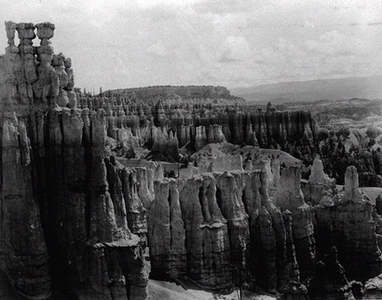BRYCE CANYON NATIONAL PARK

Bryce Canyon National Park
Bryce Canyon National Park is located in southern Utah on the eastern side of the Paunsaugunt Plateau in Garfield County. Settlement of the area began in 1874. Ebenezer Bryce moved from Pine Valley and settled a site near the mouth of Bryce Canyon in 1875. Bryce used the now famous canyon as a cattle range, and it was given his name as early as 1876.
Bryce Canyon is a series of natural amphitheaters below which stands an array of white and orange limestone columns and walls sculptured by erosion. The erosion has been accomplished mainly by rain, snow, and frost prying off cliff fragments rather than by stream erosion. Nearby streams actually flow away from the canyon. The high rim country of the park is part forest dominated by fir, pine, and aspen, and part meadows of grass and sage. At lower, drier altitudes, pinon pine and Utah juniper predominate.
Geologically, the rocks of the canyon are among the youngest of the Colorado Plateau. Despite the fragile nature of the environment, there are many miles of foot and horse trails below the rim. A twenty-mile paved highway runs along the edge of the rim. Overlooks provide magnificent views of the natural structures carved by erosion into fanciful forms that glow in delicate and varied colors.
Bryce Canyon awaited promotion and development before its full tourism potential could be realized. National Forest Supervisor J. W. Humphrey was transferred from the La Sal National Forest to the Powell National Forest on 1 July 1915. He was amazed at the beauty and grandeur of Bryce and resolved to do all he could to promote it and make it accessible. He took visiting dignitaries to Bryce and secured funds for a passable road to the canyon rim. In 1916 Arthur W. Stevens of the Forest Service wrote an illustrated article for the Union Pacific railroad tourist magazine. J. W. Humphrey wrote a similar article for the Rio Grande railroad. These were the first descriptive articles published about Bryce Canyon. In the meantime, moving pictures and postcards began circulating and Bryce began to attract visitors from all parts of the nation.
In 1919 the Utah state legislature asked Congress to create Bryce National Monument, which was done in 1923. The Union Pacific railroad acquired a state school section on the rim and began developing campgrounds, cabins, a lodge, and improved access to the Canyon. In 1928 Bryce Canyon was removed from Forest Service jurisdiction and made Bryce Canyon National Park. Later 12,000 additional acres were added to create what is now a 37,277-acre park that attracts hundreds of thousands of visitors each year from throughout the world to marvel at its unique beauty.
Disclaimer: Information on this site was converted from a hard cover book published by University of Utah Press in 1994. Any errors should be directed towards the University of Utah Press.